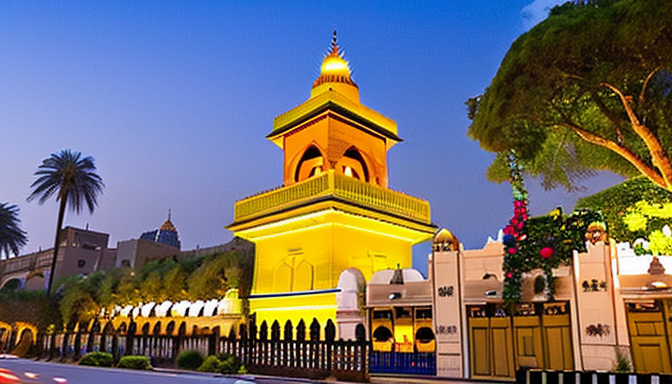Karachi, a city that never sleeps, is a treasure trove of history and culture. As you walk through its bustling streets, you can’t help but notice the stunning landmarks that tell stories of a bygone era. These buildings are not just bricks and mortar; they are a reflection of the city’s rich architectural identity. From grand mosques to colonial-era structures, each landmark has a unique tale to tell.
Take the iconic Frere Hall, for instance. Built in the 19th century, it showcases a blend of Gothic and Islamic architectural styles. It’s like a beautiful bridge between two worlds. Similarly, the Mohatta Palace stands as a testament to the opulence of the past. Its intricate design and vibrant colors draw visitors in, making them feel as if they’ve stepped back in time.
But it’s not just about aesthetics. These landmarks serve as cultural beacons. They foster a sense of community and identity among Karachi’s residents. For example, the Grand Mosque in the heart of the city is not merely a place of worship; it’s a gathering spot for people from all walks of life. It symbolizes unity and resilience.
In essence, Karachi’s landmarks are more than just historical sites; they are living, breathing parts of the city. Each one contributes to the vibrant tapestry that is Karachi. So, the next time you stroll through this bustling metropolis, take a moment to appreciate the stories these structures hold.
The Evolution of Karachi’s Architecture
Karachi’s architecture is like a storybook that reveals the city’s past. When you stroll through its streets, you can see the layers of history unfold. From the grand colonial buildings to modern skyscrapers, each structure tells a tale. Have you ever noticed how some buildings seem to whisper secrets of bygone eras?
Take the Frere Hall, for instance. Built in the 1860s, it showcases the Gothic Revival style. Its tall arches and intricate details speak of a time when Karachi was a bustling port under British rule. Then there’s the stunning Mohatta Palace, a symbol of the city’s rich heritage. With its pink stone and intricate carvings, it reflects the influence of Mughal architecture. It’s like stepping into a painting!
But Karachi isn’t just about old buildings. The National Museum and the Pakistan Maritime Museum blend modern design with cultural elements. They represent a shift towards contemporary architecture while still honoring the past. This mix creates a unique skyline that is both fascinating and inviting.
In essence, Karachi’s architectural evolution mirrors its diverse culture. Each landmark, whether a mosque, monument, or modern building, plays a role in shaping the city’s identity. It’s a reminder of where we’ve come from and where we’re headed. So next time you’re in Karachi, take a moment to appreciate these architectural gems that define the city’s character.

Cultural Significance of Key Landmarks
Karachi is a city that tells stories through its landmarks. Each building, mosque, and monument holds a piece of the city’s heart. They are not just structures; they are symbols of identity and heritage. For instance, the stunning Frere Hall, built in the 19th century, stands as a reminder of the British colonial era. Its beautiful architecture reflects the blend of cultures that define Karachi.
Then there’s the iconic Mohatta Palace, a masterpiece of Indo-Saracenic architecture. This palace was built in the late 1800s and has witnessed countless events that shaped the city. Today, it serves as a museum, showcasing the rich history of Karachi and its people. It’s like stepping back in time!
In addition to these, mosques like the grand Masjid-e-Tooba are not just places of worship; they are architectural wonders. Known for its massive dome, it symbolizes unity and peace. Such landmarks foster a sense of community among residents. They gather here, celebrating festivals, sharing stories, and creating memories.
These places are essential threads in Karachi’s cultural fabric. They remind us of where we came from and inspire us to look forward. Without these landmarks, Karachi would lose its unique identity. They are the soul of the city, connecting generations through their stories.
Frequently Asked Questions
- What are some of the most iconic landmarks in Karachi?
Karachi is home to several iconic landmarks such as the Quaid-e-Azam’s Mausoleum, Frere Hall, and the Mohatta Palace. Each of these sites holds a unique story that contributes to the city’s vibrant history.
- How has the architecture of Karachi evolved over the years?
The architecture in Karachi has evolved significantly, influenced by various cultures and historical events. From colonial-era buildings to modern skyscrapers, the city showcases a rich tapestry of styles that reflect its diverse heritage.
- Why are these landmarks important to Karachi’s identity?
These landmarks are not just structures; they are symbols of Karachi’s history and community. They foster a sense of belonging and pride among residents, serving as reminders of the city’s past and its ongoing journey.
- Can visitors explore these landmarks?
Absolutely! Many of Karachi’s landmarks are open to the public, allowing visitors to explore their historical significance and architectural beauty. Guided tours are often available to enhance the experience.
- Are there any events held at these landmarks?
Yes, various cultural and historical events are often hosted at these landmarks, celebrating Karachi’s rich heritage and bringing the community together. It’s a great way to experience the city’s culture firsthand!